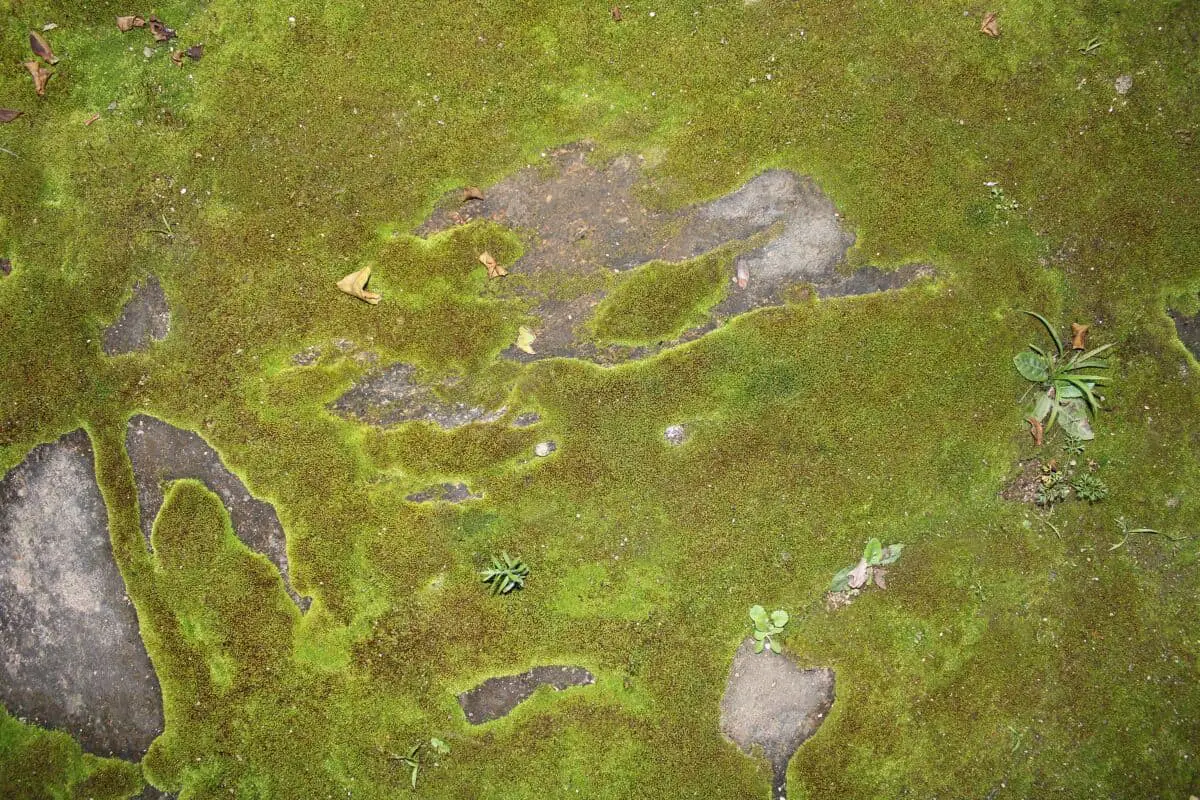Algae that grow on wood, stone, brick, or anywhere else around your balcony can be quite unsightly. Whether it’s green, black, or blue, all forms of algae can damage the appearance of your balcony fairly quickly. It’s important that you treat the problem as soon as possible to prevent it from spreading.
To get rid of algae on your balcony, start by using a store-bought algae remover, scrub it down with hydrogen peroxide, and then pressure wash the area. Next, resurface the balcony wherever it has too much staining. Finally, maintain it with weekly cleanings to prevent algae from coming back.
Throughout this article, you’ll also learn the following information about getting rid of algae on your balcony:
- Detailed instructions to remove algae from the balcony
- How to keep it from staining your home
- Regular maintenance and cleaning instructions
Use a Moss and Algae Remover
Perhaps the best way to remove algae is to use a store-bought cleaner. The Wet & Forget No Scrub Outdoor Cleaner is a concentrated solution that allows you to get rid of deep algae stains in a matter of minutes. It’s budget-friendly, and you can use it on mildew, mold, algae, and many other unwanted stains.
Keep in mind that not all algae removers will be able to get rid of the staining in one application. If you notice that it’s sticking around, then there’s a high chance that the algae got deeper into the porous material. If this happens to your balcony, head onto the next step.
Scrub It with Hydrogen Peroxide
Decks-Docks recommends using hydrogen peroxide to cut back on deep algae stains. If you’re moving into a house that already has stains, you’ll most likely have to deal with a tough cleaning process. Long gaps between owners or people who’ve neglected to fix the issue both lead to an intense stain.
All you have to do is apply hydrogen peroxide to an abrasive rag, sponge, or scouring pad, then scrub it on the stains. It’ll take a bit of elbow grease, but you’ll eventually start to see the greenish-brownish tint disappear. Hydrogen peroxide can strip away stains, but it won’t restore the original look of the balcony. To make it look like-new, read on.
Pressure Wash the Algae
Using a pressure washer can make a world of a difference. Professional companies whose primary goal is to remove algae stains often reach for the undeniable effectiveness and power of pressure washers. As Patio Comfy states, your pressure washer can use either hot or cold water; It doesn’t matter which you choose.
Algae usually branch off in strings, also known as hairs. When the hairs expand and dig deeper into your balcony, they leave behind their coloring. When you use a pressure washer, it dives through the hairs, ripping them out and removing the stains without damaging the durable surface of your balcony.
Stop the Algae in Its Tracks
A tried and true method of ridding your balcony of algae is to always stay on top of the problem. Some areas are far more susceptible to stains and algae growth. If you live in a humid environment, such as near the coast or a large lake, then you might notice algae and mold growth on the outside of your own.
If you can keep it dry with floor fans, dehumidifiers, and cleaning methods, then you’ll be able to get rid of the algae completely. To learn more about specific maintenance and cleaning, check out the final section. As mentioned above, moving air and keeping it dry won’t allow algae’s hairs and strands to spread around the balcony.
Apply Water Repellent Solutions
Ecoform Europe points out the excellent suggestion of using water-repellent solutions. If you’re noticing that algae keep growing, regardless of your attempts to remove it, then using a water shield can keep it at bay. There are dozens of products that will work. The most essential part is that it doesn’t allow water to settle on your balcony.
These repellents work by preventing the water from penetrating the porous surface. Instead, it starts to bead on top. As the beads of water grow bigger, they start to spill over the side. In short, everything pours onto the ground rather than creating a breeding ground for algae. It’s the best of both worlds!
Pour Hot Water and Brush It
Hot water is one of the most useful tools for removing algae because it loosens the substance. Cold water slows the molecules, whereas high temperatures will loosen them up a bit to make it easier for you to clean. Once the algae are loosened, use an abrasive brush and scrub away at the surface until it’s gone.
Note: If the surface is painted, brittle, or otherwise coated, use gentle motions. You might even want to consider using a soft bristle brush to prevent damage from occurring. You’ll likely have to treat the stains, so proceed to the next section for more details.
Resurface or Stain the Balcony
Resurfacing and staining your balcony will complete the process of getting rid of algae. Use wood stainers, brick restoring solution, and concrete renewers to bring life back to your balcony. There’s no purpose in removing the algae stains if you’re not willing to revitalize the material! After all, it helps the appearance as well as the longevity of the balcony.
Many modern wood stainers and restoring solutions come with a subtle coat of algae, mold, and mildew preventatives. Try to match the color code of your balcony to achieve a seamless appearance.
Remove Excess Moisture
As mentioned above, excess moisture often leads to algae and mold growth. It’s often combined with the foul odor of mildew, none of which you want to deal with. A great prevention method is to clean pools of stagnant water from your balcony as soon as possible. Use fans or rags to keep it dry during rainy seasons.
Gnats, mosquitoes, and other insects are also attracted to stagnant water. By removing the source, you’ll be preventing them from showing up while also ridding your balcony of mold spores and algae. It’s a win-win situation for such a simple prevention method.
Wash the Balcony Weekly
Aside from removing moisture, you should make it a habit to keep your balcony as clean as possible. Dirt and grime that starts to build up eventually lead to all sorts of nasty problems. On that note, never leave food scraps on the balcony. You shouldn’t have any trash cans or compost bins anywhere near it since they both invite bacteria.
For your weekly balcony cleaning, you don’t need to pull out the pressure washer or use hydrogen peroxide. Simply spray it down with water, use a few drops of all-purpose cleaner, scrub it down, and spray it off. The whole process shouldn’t take more than 10 to 15 minutes, but it can prevent long-term damage caused by algae growth.
Conclusion
Algae is an annoying problem when it’s on your balcony, but did you know that you can remove it in less than an hour? By using the numerous helpful tips and steps throughout this page, you’ll be able to keep your balcony looking spotless, fresh, and clean all year long.
Here’s a quick recap of the post:
- Use a pressure washer to remove deep algae stains.
- Hot water and a sponge is sometimes all you need to remove algae.
- Never leave food scraps or moisture on your balcony.
- Algae stains can reduce the longevity and durability of brick, wood, and other materials.

